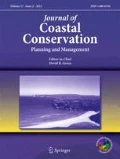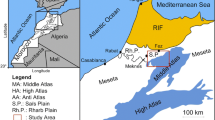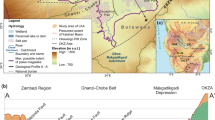Abstract
Environmental isotope analyses in conjunction with the hydro-geochemical investigations and tentative reviewing of the paleoclimatic sea level changes are carried out to fingerprint the implications of climatic changes on the groundwater flow regime and geochemistry at the Nile Delta. Following up the footprints of groundwater flow history, it is observed that the Pleistocene, main groundwater aquifer of the Nile Delta was drained and refilled with Nile water several times due to the eustatic sea level propagations between dry and wet periods. Therefore, the present-day groundwater flow regime could be affected by the latest Holocene phase of climate changes during which no significant dramatic sea level changes were recorded. After the time slice of the Mediterranean humid phase, 8000-5500 BP, the sea level started to rise steeply from –15 m to the present-day level. Under this rising rate, the seawater invaded most of the northern delta lope and several 10ths of kilometres inland via the mouths of the ancient Nile branches. During these arid conditions, deterioration of the Pleistocene unconfined aquifer could take place. This finding matches a famine and economic instabilities during the arid periods and flourishing and economic stabilities during the humid pluvial periods along the history of the ancient Egyptian civilization. In accordance to the latest active sea level rise stage in conjunction with the delta subsidence, a contagious groundwater level rise with a recent order of 3 cm/year is taking place leading to form several lake-like lagoons, water logging and soil salinization along the coastal plain and the eastern low lands. The Nile Delta is expected to suffer extreme soil salinization and gradual merging under the groundwater logging and seawater transgression especially, along the eastern coastal zone which suffers a high subsidence rate of about 5 mm/year. In contrast to previous studies, our findings show that, the present groundwater composition and salinity in the Nile Delta aquifers cannot be attributed to a recent seawater intrusion. The physico-chemical processes that explain this composition are combination of salt dissolution (mainly from Holocene fluvio-marine aquifer), flushing by recent Nile water, ion exchange and evaporation.





















Similar content being viewed by others
References
Aeschbach-Hertig W, El-Gamal H, Dahab K, Kipfer R, Hajdas I, Bonani G (2006) Using environmental tracers to assess groundwater resources in reclamation areas of Egypt. Geophys Res Abstr 8:05515
Alexandra T, Janne B, Romain A, Francois F, Francois M (2013) Egyptian mummies record increasing aridity in the Nile Valley from 5500 to 1500 yr before present. Earth Planet Sci Lett 375:92–100
APHA (1985) American Public Health Assoc.: standard methods for the examination of water and waste water, 16 Ed., APHA, Washington, DC., 1268 pp
Armanious SD, Khalil JB, and Atta SA (1988) Groundwater hydrology, geological and hydrogeological features of the Nile Delta Quaternary aquifer, Egypt. J Civil Eng No. 23-Vol.1, pp. 50–65
Arnous MO, Green DR (2015) Monitoring and assessing waterlogged and salt-affected areas in the Eastern Nile Delta region, Egypt, using remotely sensed multi-temporal data and GIS. J Coast Conserv 19:369–391. doi:10.1007/s11852-015-0397-5
Arnous MO, El-Rayes AE, Green DR (2015) Hydrosalinity and environmental land degradation assessment of the East Nile Delta region, Egypt. J Coast Conserv. doi:10.1007/s11852-015-0402-z
Awad MA, Nada AA (1992) Tritium content of groundwater aquifer in western Nile Delta. J Isotopen Prates USA 28:167–173
Bard E, Hamelin B, Fairbanks RG (1990) U-Th age obtained by mass spectrometry in corats from Barbados: sea level during the past 130,000 years. Nature 340:456–458
Bell B (1971) The dark ages in ancient history. I. The first dark age in Egypt. Am J Archaeol 75:1–26
Bell B (1975) Climate and the history of Egypt, the Middle Kingdom. Am J Archaeol 79:223–269
Coplen TB (1996) New guidelines for reporting stable hydrogen, carbon, and oxygen isotope-ratio data. Geochim Cosmochim Acta 60:3359–3360
Craig H, Gordon LI (1965) Deuterium and oxygen-18 variations in the ocean and the marine atmosphere. In: Tongiorgi E (ed) Stable Isotope in Oceanographic Studies and Paleotemperatures. Laboratorio di Geologia Nucleare, Pisa, pp 9–130
Diab MSh, Dahab KA, and El-Fakharany MA (1997) Impact of paleohydrogeological conditions on the groundwater quality in the northern part of the Nile Delta, Egypt. Egyp J Geology 41/2B. pp. 779–796
El Fawal FM, and Shendi EH (1991) Sedimentology and groundwater of the Quaternary sandy layer north of Wadi El Tumilat, Ismailia, Egypt. Ann Geol Surv Egypt, v. xvii, pp 305–314
El-Asmar HM, Taha MM, El-Kafrawy SB, El-Sorogy AS (2015) Control of Late Holocene geo-processes on the sustainable development plans of the Tineh Plain, NW Sinai coast, Egypt. J Coast Conserv 19:141–156. doi:10.1007/s11852-015-0377-9
El-Fishawi NM, and Badr AA (1995) Erosion and flooding as related to recent sea level rise, Nile Delta Coast, Egypt, Proc. II Int. Conf. Med. Coast Environ. “MEDCOAST-95,” Tarragona, 1995, vol. 2, pp. 1229–1239
Fairbanks RO (1989) A 17000 year glacioeustatic sea-level record: influence of glacial melting rates on the Younger Dryas event and deep ocean circulation. Nature 342:637–642
Fontes JC, Yousfi M, Allison GB (1986) Estimation of long-term diffuse groundwater discharge in the northern Sahara using stable isotope profiles in soil water. J Hydrol 86:315–327
Geirnaert W, Laeven MP (1992) Composition and history of groundwater in the western Nile Delta. J Hydrol 138:169–189
Geriesh MH (1990) Hydrogeological studies west Ismailia, Egypt. M.Sc. Thesis, Fac. of Sci., Suez Canal Univ., Ismailia, Egypt
Geriesh MH (1995) Hydrogeological and hydrogeochemical evaluation of groundwater resources in the Suez Canal Region, Egypt. Ph. D. Thesis, Fac. of Sci., Suez Canal Univ., Ismailia, Egypt
Geriesh MH (2000) Paleohydrogeological regime of groundwater flow in the eastern Nile Delta Region, Egypt. Proceedings of the 4th inter. Conf. Water supply and water quality, Krakow, Poland, pp. 229–241
Geriesh MH (2003) Reconstruction of the paleohydrogeological regime of groundwater flow in the Quaternary aquifers in the Nile Delta, Egypt. 48th Midwest Groundwater Conference, Kalamazoo, W. Michigan University, USA, 1–3 October, 2003
Geyh MA, Jakel D (1974) Late Glacial and Holocene climatic history of the Sahara desert derived from a statistical assay of 14C dates. Palaeogeogr Palaeoclimatol Palaeoecol 15:205–208
Gössling S (2002) Global environmental consequences of tourism. Glob Environ Chang Hum Policy Dimens 12(4):283–302
Hassaan MA (2013) GIS-based risk assessment for the Nile Delta coastal zone under different sea level rise scenarios case study: Kafr El Sheikh Governorate, Egypt. J Coast Conserv 17:743–574. doi:10.1007/s11852-013-0273-0
Hassan FA (1981) Historical Nile floods and their implications for climatic change. Science 212(4499):1142–1145
Hassan FA (1997) The dynamics of a riverine civilization: a geo-archaeological perspective on the Nile Valley, Egypt. World Archaeol 29:51–74
IPCC (2007) Summary for Policymakers, in Climate Change 2007: impacts, adaptation and vulnerability. Contribution of Working Group II to the Fourth Assessment Report of the Intergovernmental Panel on Climate Change, Cambridge University Press, Cambridge, UK, p. 17
Jones A, Phillips MC (2011) Disappearing destinations: climate change and future challenges for coastal tourism. CAB International, Wallingford
Kemp BJ (2006) Ancient Egypt Anatomy of a Civilization, 2nd edn. Routledge, London
Kitchen KA (1991) The chronology of ancient Egypt. World Archaeol 23(2):201–208
Mikhailova MV (2001) Hydrological regime of Nile Delta and dynamics of its coastline. Water Resour 28(5):477–490
Perissorateis C, Conispoliatis N (2003) The impacts of sea-level changes during latest Pleistocene and Holocene times on the morphology of the Ionian and Aegean seas (SE Alpine Europe). Intr. J. Mar Geol 196:145–156
Phillips MC, Jones AL (2006) Erosion and tourism infrastructure in the coastal zone: problems, consequences and management. Tour Manag 27(3):517–524
Rognon P, Williams MA (1977) Late Quaternary climatic changes in Australia and North Africa: a preliminary interpretation. Palaeogeogr, Palaeclimatol Palaeooecol 21:285–327
Said R (1993) The evolution of the Nile Delta. Geoscientific research in Northeast Africa, Thorwehe and schandelmeir (eds). Balkema, Rotterdam, pp. 615–619
Sandford KS, Arkell WJ (1939) Palaeolithic Man and the Nile Valley in Lower Egypt. The Univ. of Chicago press, Chicago, 105 pp
Shata A and El Fayomy IF (1970) Remarks on the hydrogeology of the Nile Delta. Proc. sysm. Hydrogeology of Deltas, UNESCO v. II
Simpson HJ, Hamza MS, White JW, Nada A and Awad MA (1987) Evaporative enrichment of Deuterium and 18O in arid zone irrigation. In Isotope Techniques in water resources development. IAEA-SM,299/125, pp. 241–256
Stanley JD, Krom MD, Cliff RA, Woodward JC (2003) Short contribution: Nile flow failure at the end of the Old Kingdom, Egypt: strontium isotopic and petrologic evidence. Geoarchaeology 18:395–402
Staubwasser W, Sirocko F, Grootes PM (2003) Climate change at 4.2 ka BP termination of the Indus valley civilization and Holocene south Asian monsoon variability. Geophys Res Lett 30:1425–1428
UNEP/PAP (2009) Sustainable coastal tourism. An integrated planning and management approach. United Nations Environment Programme/Priority Actions Programme, Split
Vera T, Luis C, Juergen P (2013) Increasing pressure, declining water and climate change in north-eastern Morocco. J Coast Conserv 17:379–388
Weiss B (1982) The decline of Bronze Age civilization as a possible response to climate change. Clim Chang 4(2):173–198
Zaghloul ZM, Taha HH, Hegab OA and El Fawal FM (1979) The Plio-Pliostocene Nile Delta subenvironments; stratigraphic section and genetic class. Geol. Soc. Vol. 1x, Cairo
Author information
Authors and Affiliations
Corresponding author
Rights and permissions
About this article
Cite this article
Geriesh, M.H., Balke, KD., El-Rayes, A.E. et al. Implications of climate change on the groundwater flow regime and geochemistry of the Nile Delta, Egypt. J Coast Conserv 19, 589–608 (2015). https://doi.org/10.1007/s11852-015-0409-5
Received:
Revised:
Accepted:
Published:
Issue Date:
DOI: https://doi.org/10.1007/s11852-015-0409-5




